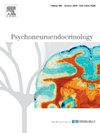Experiences of discrimination during pregnancy predict altered neonatal hair cortisol at birth
IF 3.4
2区 医学
Q2 ENDOCRINOLOGY & METABOLISM
引用次数: 0
Abstract
Objective
Prenatal glucocorticoids (e.g., cortisol) are a widely proposed prenatal programming mechanism, yet few studies directly measure fetal cortisol. Neonatal hair provides a non-invasive method to assess fetal cortisol. The current studies test the association between maternal exposure to discrimination and fetal cortisol, as measured in neonatal hair, in two cohorts.
Methods
Study 1: Pregnant individuals (N = 65) and their neonates (61.8 % female) participated in study 1 between 2017 and 2021. Participants self-identified as Asian (6.2 %), Black (21.5 %), Latinx (35.4 %), Multiracial or Multiethnic (35.4 %), and Native Hawaiian or Pacific Islander (1.5 %). Experiences of discrimination were measured using the Everyday Discrimination Scale. Neonatal hair samples were collected close to birth (Mediandays=1.30, IQRdays=0.96–2.03).
Results
Study 1: Higher experiences of everyday discrimination among pregnant individuals were associated with lower hair cortisol levels in neonates (r = -.28, p = .031).
Methods
Study 2: Pregnant individuals of Mexican descent (N = 73) and their neonates (50.7 % female) participated in study 2 between 2017 and 2020. Participants reported on their exposure to experiences of discrimination using the Discrimination Stress Scale, and neonatal hair samples were collected shortly after birth (Mediandays=13.0, IQRdays=11–18).
Results
Study 2: Those who had higher discrimination stress during pregnancy had neonates with higher cortisol than those with low discrimination (F(1,70)= 3.78, p = .03), but this relation did not remain significant after controlling for gestational age.
Conclusion
Across two cohorts, higher experiences of discrimination were associated with alterations in neonatal hair cortisol. Both higher and lower neonatal hair cortisol are linked to poorer neonatal development, indicating that experiences of discrimination might be a potential source of health disparities in the next generation.
怀孕期间的歧视经验预测出生时新生儿毛发皮质醇的改变
目的产前糖皮质激素(如皮质醇)是一种被广泛提出的产前编程机制,但很少有研究直接测量胎儿皮质醇。新生儿毛发提供了一种评估胎儿皮质醇的非侵入性方法。目前的研究在两个队列中测试了母亲暴露于歧视和胎儿皮质醇之间的关系,通过新生儿毛发来测量。方法研究1:2017 - 2021年孕妇(N = 65)及其新生儿(女性61.8% %)参与研究1。参与者自我认定为亚洲人(6.2% %)、黑人(21.5% %)、拉丁裔(35.4% %)、多种族或多民族(35.4% %)、夏威夷原住民或太平洋岛民(1.5% %)。歧视经历是用日常歧视量表来衡量的。接近出生时采集新生儿毛发样本(Mediandays=1.30, IQRdays= 0.96-2.03)。研究1:孕妇的日常歧视经历越多,新生儿毛发皮质醇水平越低(r = -)。28日,p = .031)。方法研究2:2017 - 2020年,墨西哥裔孕妇(N = 73)及其新生儿(女性50.7 %)参与研究2。参与者使用歧视压力量表报告他们遭受歧视的经历,并在出生后不久收集新生儿头发样本(Mediandays=13.0, IQRdays= 11-18)。结果研究2:妊娠期歧视应激高的孕妇所生的新生儿皮质醇高于歧视应激低的孕妇(F(1,70)= 3.78,p = .03),但在控制胎龄后,这种关系不显著。结论:在两个队列中,较高的歧视经历与新生儿毛发皮质醇的改变有关。新生儿毛发皮质醇水平的高低都与较差的新生儿发育有关,这表明受到歧视的经历可能是下一代健康差异的潜在来源。
本文章由计算机程序翻译,如有差异,请以英文原文为准。
求助全文
约1分钟内获得全文
求助全文
来源期刊

Psychoneuroendocrinology
医学-精神病学
CiteScore
7.40
自引率
8.10%
发文量
268
审稿时长
66 days
期刊介绍:
Psychoneuroendocrinology publishes papers dealing with the interrelated disciplines of psychology, neurobiology, endocrinology, immunology, neurology, and psychiatry, with an emphasis on multidisciplinary studies aiming at integrating these disciplines in terms of either basic research or clinical implications. One of the main goals is to understand how a variety of psychobiological factors interact in the expression of the stress response as it relates to the development and/or maintenance of neuropsychiatric illnesses.
 求助内容:
求助内容: 应助结果提醒方式:
应助结果提醒方式:


